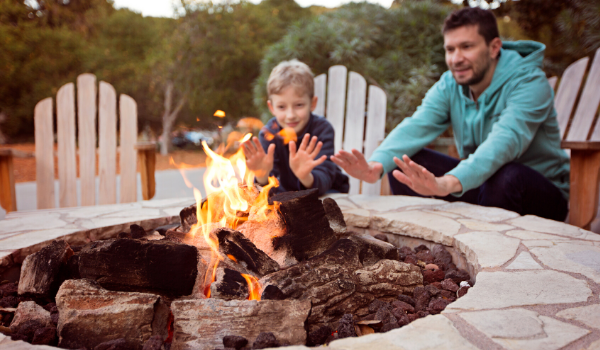Gas vs Wood Firepit: 9 Factors to Consider
Ready to take your neighborhood get-togethers to the next level? Gathering with friends and family around a nice firepit in your backyard living area will do just the trick. A firepit is a great addition to any backyard and comes in a variety of sizes and styles. But, what type of firepit is best for your outdoor space? While either type can be adapted to virtually any design, there are distinct pros and cons for each. So, grab a sweatshirt and marshmallows and settle in as we take you through nine factors to consider when deciding between a gas vs wood firepit.
Gas vs Wood Firepit: 9 Factors to Consider
Fuel & Storage
Gas firepits require liquid propane or natural gas, while wood firepits require dry wood. Regardless of the type you choose, you must have a supplier for your fuel, whether it be a reliable source for good firewood or propane or natural gas.
Wood firepits require storage for firewood. The wood must stay dry and should be stored away from the home as wood can hold termites. Similarly, gas firepits need a dedicated space for a large storage tank, ranging from 15 to 100 gallons. Bear in mind that the tank may be an eyesore, so additional landscaping may be required to cleverly disguise the tank.
Installation
Both firepit types should be installed by a professional. Gas firepits are more difficult to install as they must be connected to gas lines. This means the installation may take more time and be more expensive.
While installation for a wood firepit is straight forward, and subsequently quicker, a professional will be able to place the wood firepit in your backyard the appropriate distance from your home.
Style & Size
Both types of firepits can be adapted to virtually any style, and both types can be featured as a stone firepit. Both types vary in size. Generally, a wood firepit is larger than a gas firepit. Wood fire pits also require dedicated storage for firewood. While gas firepits may seem like the better option if you are tight on space, bear in mind that they require space for the storage tank.
Start-Up Time and Experience
Gas firepits are like magic—snap your fingers, and voila—fire! The start-up time for fire with a gas firepit is as simple as turning on a switch and lighting a match. With a wood firepit, there is the time and effort required to build and kindle a fire. Also, gas firepits generate continuous and even heat more quickly than a wood firepit.
While generating a fire with a gas firepit does indeed seem magical, gas firepits can often lack the magical quality a fire from a wood firepit gives. There’s nothing quite like the ambience a wood fire provides. From the crackling of the wood to the distinct smell, a wood fire provides an unmatched experience.
Maintenance
Wood firepits generate soot and ash, which will need to be cleaned out regularly from the pit. As stated previously, wood firepits also require firewood, which must be stored appropriately and carried to the pit for use.
Gas firepits require little maintenance as there is little to clean since gas burns so cleanly. The outside of the pit can be cleaned on occasion. A cover can be used to shelter the pit during rain or snowstorms.
Cost
The cost for a wood firepit varies based on the size and the type of brick or stone used to build the firepit. Generally, you can expect the final cost of a wood firepit to be less than gas for wood and materials.
The cost for a gas firepit also varies based on size and materials. However, a gas firepit, especially with installation, comes with a higher price tag when all is said and done.
Bear in mind, there is also an associated cost to maintain each type of firepit. When comparing gas vs wood firepits, wood firepits seemingly win this battle as wood is typically cheaper than gas. There also may be an associated cost with any landscape needed to hide a gas tank or build a storage structure for firewood.
Effect on the Environment (And Your Breathing)
Although wood is a renewable resource ideal for the environment, it does not burn as cleanly as gas. Gas burns produce fewer emissions than wood, which makes it more energy efficient. Gas is also the better choice for those with breathing issues like asthma, as the particles from wood can irritate airways.
Permits
Wood fire pits may be subject to local laws or burn bans in certain regions. Certain neighborhoods may require a permit to have a firepit on your property. Play it safe and check with your local municipality’s laws, as well as your Homeowner’s Association guidelines.
Safety
The last, and most important, factor to consider is safety. Instituting routine maintenance plans for both types of firepits is your best bet to ensure the safety of you, your loved ones, and your home. Gas firepits should be checked thoroughly for any leaks. Wood firepits should be cleaned regularly to clear soot and ash. Be sure to completely extinguish a wood fire properly. Wood firepits should also be installed away from any flammable structures.
Do you have more questions or still need help deciding which is best for you? Haynes is here to help you decide between a gas vs wood firepit. Visit our Connecticut Outdoor Living showroom or contact us today to get started!

